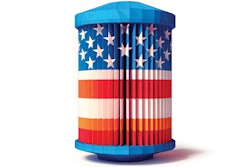Few technologies in memory have risen to dominate our industry as quickly as salt chlorine generators. Estimates of the percentage of new pools receiving them range from 40 to 70 percent, and the current population of salt pools is judged to be over one million, depending on who is asked.
A spectacular success, mainly due to convenience. Consumers of every stripe crave solutions that are simpler and less taxing on the brain; that's what salt chlorine generators provide.
But while this technology does reduce the demands on the pool owner, it does not eliminate them entirely. The salt chlorine generator is not a panacea, and there are issues with its use that continue to emerge as more and more units are installed, says Bob Harper, general manager of Pristiva, a salt manufacturer owned by Compass Minerals.
Harper is a longtime industry veteran, and represents Pristiva's substantial research investment in salt chlorine generator technology and its impact on the pool industry. In an effort to comprehend the broad picture of the effect of the sudden, massive market invasion by salt chlorine generators, Pristiva has brought in a number of technical specialists and interviewed over 300 builders, service technicians and retailers to research salt pools.
"The burgeoning popularity of this salt chlorine technology has outstripped understanding of its proper use," Harper says. "A lot of salt chlorine generators have been sold with a 'set it and forget it' kind of mentality, but these things don't work like that, and that's not the way they should be sold. Because when problems arise, the consumer says, 'Hey, I did what the guy told me, and now I have a problem.'
"Salt chlorine generators require a level of oversight and maintenance just like anything else."
Dismantling Chemicals
A range of issues have surfaced since the introduction of the technology, Harper says, from relatively simple matters like fine tuning chlorine output to larger matters such as the breakdown of common pool chemicals within the generator cell - perhaps the most significant problem the Pristiva group has uncovered.
The story goes like this: For decades pool chemicals were developed for use in pools where pre-made chlorine was added, either by hand or by some automated means. When the salt chlorine generator arrived on the scene, it was treated as if it were another chlorine delivery mechanism.
But in reality, these units are more like small chlorine factories that take in salty pool water and output chlorine. Inside the factory, however, work proceeds under some rather extreme conditions. At some points inside the generator, chlorine concentrations can reach 50 ppm (the normal recommended level for pool water is a maximum of 4 ppm), pH can be either close to 14 or 0 (normal levels are between 7.2 and 7.8) and temperatures can exceed 120 degrees.
Other chemicals present in the pool water along with the salt can break down when exposed to these conditions, Harper notes, becoming ineffective at best, and harmful new compounds at worst.
So while the water throughout most of the pool may be perfectly balanced, says Kirk Mitchell of Kirk Mitchell and Associates, Marietta, Ga., "at the interface with the chlorine generator you are producing chlorine at very high levels. In the presence of that combination of high chlorine and either very high or very low pH (depending on which electrode you are near), some of the conventional chemicals out there will undergo what is known as hydrolysis, where they're chemically attacked. This is occurring in a very finite area of the cell, but it's occurring."
A prime example is HEDP, a chemical commonly incorporated in startups, but often reapplied at various frequencies. "It's one of the most popular anti-scaling or sequestering agents used in the industry," says Harper. "Phosphorus-based HEDP, or phosphonic acid, works pretty well in a traditional pool to control stain and scale, but in a saltwater pool where you have these extreme conditions, this product tends to degrade and break down into orthophosphate."
Steve Carlyle, a consultant with Pristiva with three decades of experience in the pool business as well as expertise in salt, picks up the story here. "Orthophosphate is a double-edged problem in pools," he says.
"First of all, orthophosphate is a fertilizer; it's an excellent plant food. In the pools we looked at, once HEDP had broken down into orthophosphate, the moment the chlorine residual dropped in the pool for whatever reason, we were seeing algae just take off."
Unfortunately, that was only part of the problem. "At the same time," Carlyle says, "orthophosphate also is one of the fastest-forming types of scale, and it formed on the cell itself and other surfaces. Phosphate scale itself is easily removed, but it promotes other forms of scale that tend to layer in right on top of it, and these are very difficult to remove. Phosphate scale acts like a primer for more-problematic forms of scale such as calcium carbonate and other sulfate forms.
"People were using this product to prevent scaling on a salt chlorine generator cell, but instead it was degrading into an orthophosphate and actually promoting scaling and in fact shortening the life of the cell. And finally, the generator couldn't produce chlorine as well because it was partially scaled up, while at the same time algae was being stimulated with its favorite food."
So in effect, a chemical added to prevent scale and stain was not only reduced by the chlorine generator, but also changed into a substance that promotes scaling and algae growth, while at the same time inhibiting the generator's ability to fight algae.
Carlyle cites the astronomical chlorine level as the real culprit. "Chlorine is just a tough chemical - it's a great oxidizer and it's effective at killing bacteria and algae, but it's also effective at dismantling a lot of chemicals. Most of these chemicals that we're talking about have been designed to withstand about 10 ppm of chlorine - that's about the level you would shock the pool. They're just not able to withstand the 50 ppm they see inside the generator."
The focus of the problem has been at pool openings, he adds. "It's long been a practice of builders to add stain and scale control agents when filling a new pool, because they know if they don't, they'll have some problems. But now, starting up a salt pool, the stuff they normally add gets torn up when it goes through the chlorine generator. They've been treating new pools with salt chlorine generators the same way they had ordinary pools, blissfully thinking that it was working the same way it always had.
"And many of them didn't understand that a month after startup they were having staining and scaling problems because the chemicals they added initially were no longer working. They'd been degraded by the salt chlorine generator.
"There still exists a great lack of understanding of the causes of these types of problems. People see them from time to time and just kind of write them off as an anomaly, or use the old standby excuse, 'the consumer must have done something to that pool.'"
The Strength Of Ions
Another issue that has risen in prominence alongside salt chlorine generators is the effect of increased salt levels on cementitious pool surfaces. Salt in water forms ions, which, in sufficient concentration, can most certainly cause problems for pool surfaces.
Mitchell has studied the problem in some depth, experimenting with test pools to determine the levels at which salt can develop a deleterious effect.
"There's been an underlying assumption that the presence of salt with high ionic strength was detrimental to cementitious surfaces," he says, but he notes that problems can be avoided with greater focus on water balance and proper addition of pool salt.
"What I want people to understand is that this can be effectively handled through the use of the LSI (Langelier Saturation Index)," he says. "They can tune the environment in a saltwater pool. These saltwater pools are no more aggressive to surfaces than any other sanitization system if properly managed through the LSI."
A crucial point Mitchell makes is that dissolved, circulating salt does not pose much of a problem, but undissolved pool salt lying against the surface of a pool, does.
"Where the salt is in direct contact with the cementitious surface, that ionic strength is a lot higher," he says, "and that's a completely different scenario."
Many pool professionals will leave undissolved pool salt lying on the floor and adhering to the sides of a pool, he says, and that can damage the surface. "That's why I always recommend brushing the salt until it's all dissolved."
Salt Is Not Salt
Along with the effects of saltwater on a pool's surface, it's important to consider what may be riding along with the NaCl in a bag of pool salt. Pool owners and some pool professionals are inclined to think of pool salt as pure sodium chloride, but of course it is not. No such product exists.
Salt is produced at varying levels of purity, and this matters because an enormous amount of salt is poured into a pool over its lifetime. At startup for a 20,000 gallon pool, for instance, 13 to 16 bags of salt will be dumped into the water. That's a lot of salt.
Calculating the potential effect is easy. With perhaps 600 pounds of salt going into the pool, even if it contains only 1 percent of organics or metals (and some salts contain much more than that), that's 6 pounds of contaminant going into a brand new pool.
In the usual process of opening a pool, notes Carlyle, the salt is added, it may be brushed in a bit, the chlorine reading is checked, and that's it. But if the salt contains substantial amounts of organic material, it will chew up the chlorine from the shock, and may consume everything the salt chlorine generator puts out, as well.
"So here's a person who has done everything right," he says, "but a week later the pool has turned green and the homeowner can't get any chlorine reading."
The point is that all salt contains impurities and an awareness of these should guide decision making.
Primarily, there are three different methods of producing salt for commercial consumption. It can be mined, mechanically evaporated or dried out from seawater under the sun, and these methods impact the salt's purity.
This last method produces what is known as solar salt. In this process, the manufacturer builds some kind of containment pond and pumps saltwater into it, and then waits for the sun to dry it out.
During this period of time, the salty brine is exposed to the general environment and the creatures that inhabit it, from bacteria to birds. This solar salt tends to be the cheapest of the three main types.
Mined salt is obtained by some means from salt deposits underground. The operation may be akin to coal mining, where the salt is extracted by workers and machines, or water may be pumped through the salt and then to the surface. These underground deposits vary in their makeup and may contain impurities as well.
Finally, brine can be evaporated in a factory, where it is boiled to separate off the water.
"It's true that different production methods lead to differences in the purity of salt," says David Rude, president of Aquasalt, Houston. "Does it affect pool chemistry? That debate is never going to end."
He notes that many products are marketed at different grades of quality. "If you are a swimming pool owner, you may want to have the highest-purity product, that may be important to you. But then again, you may not. Maybe what is most important to you is cost."
The Big Picture
A common paradigm of the pool and spa industry is the tendency for each segment to focus on its own issues, while a larger industry-wide picture remains somewhat obscure. The advent of salt chlorine technology is another example of this, says Harper.
"People have been looking at their own little piece of the pie, equipment people focused on equipment, chemical people focused on water chemistry, finish guys focused on finishes, and nobody has been taking a holistic view of saltwater pools."
Pristiva's research has shed some light on this rapidly growing sanitizing system. If the technology is to realize its potential to make pools simpler to own, a broader understanding will have to be developed and employed.








































